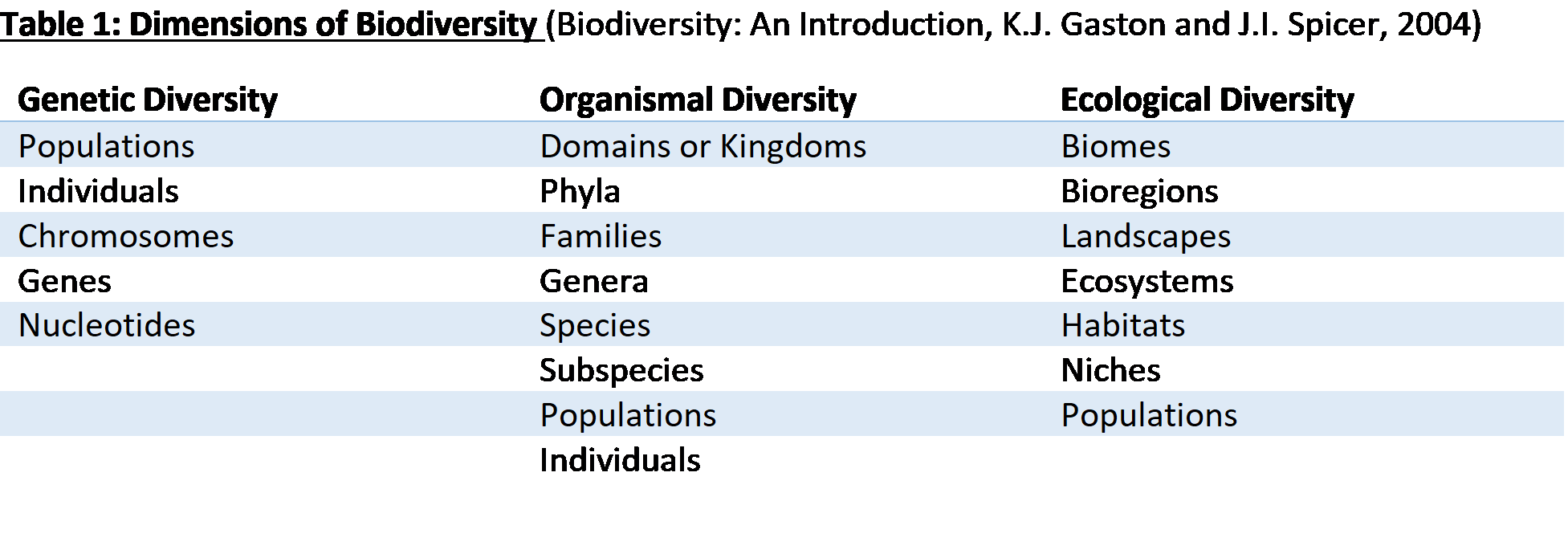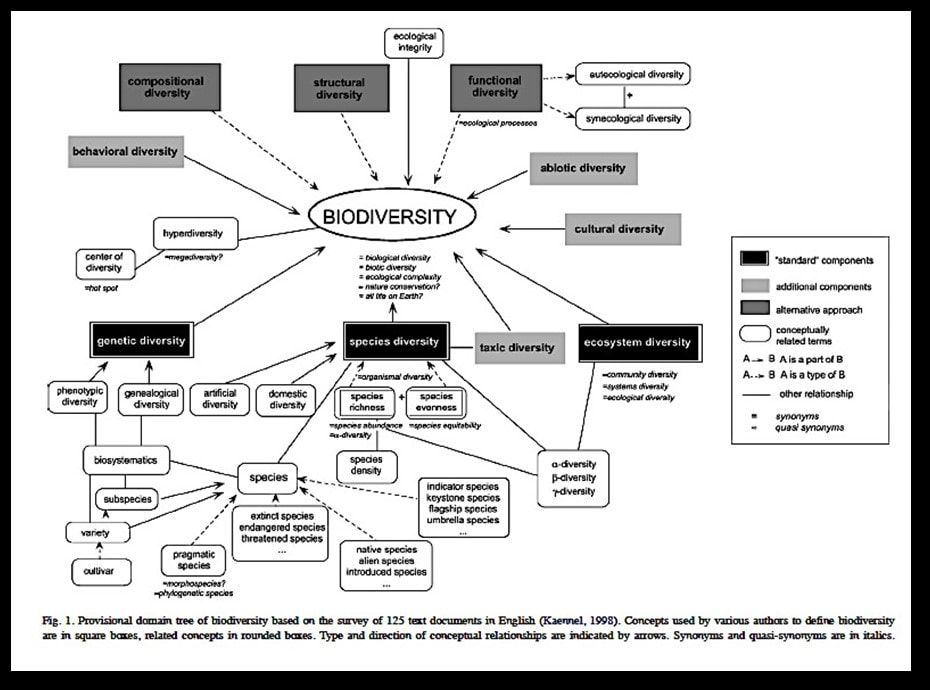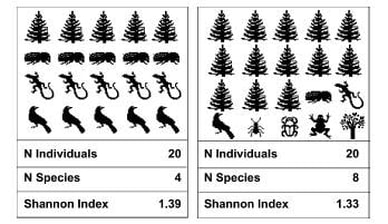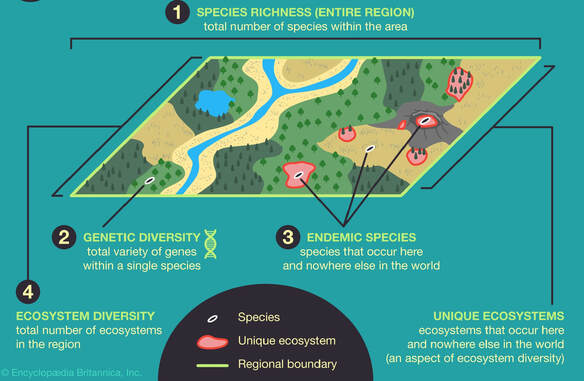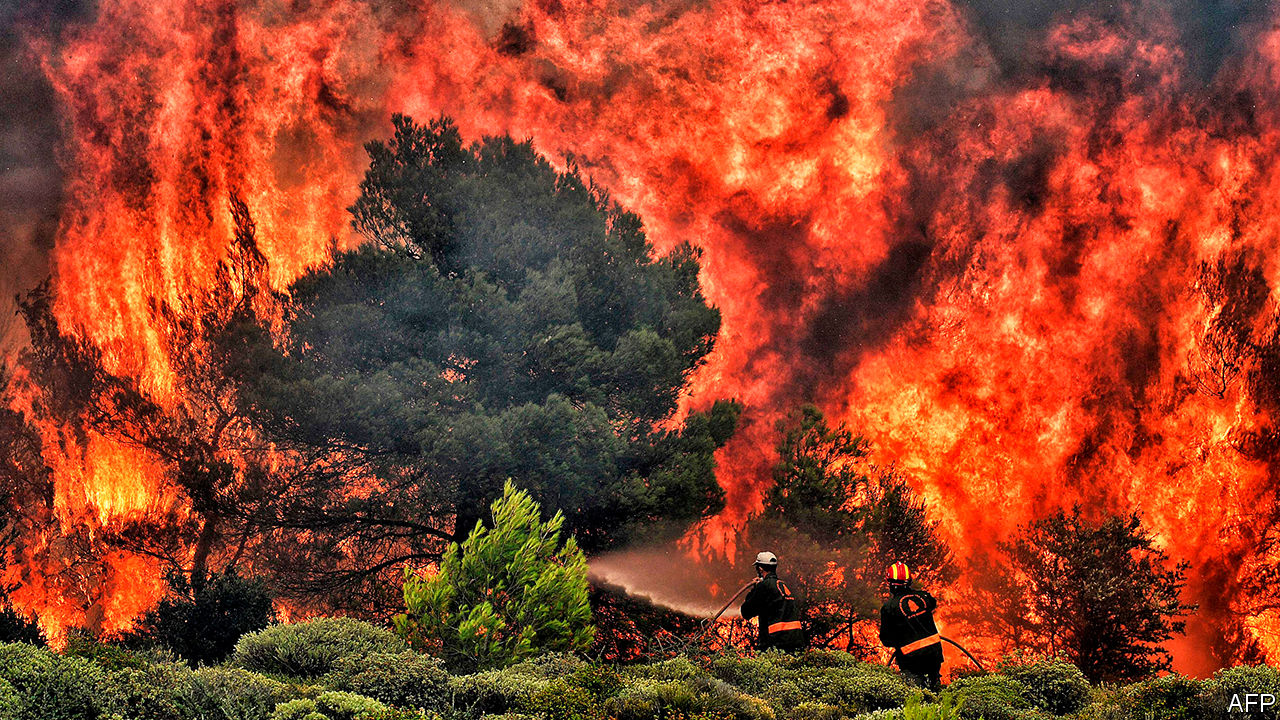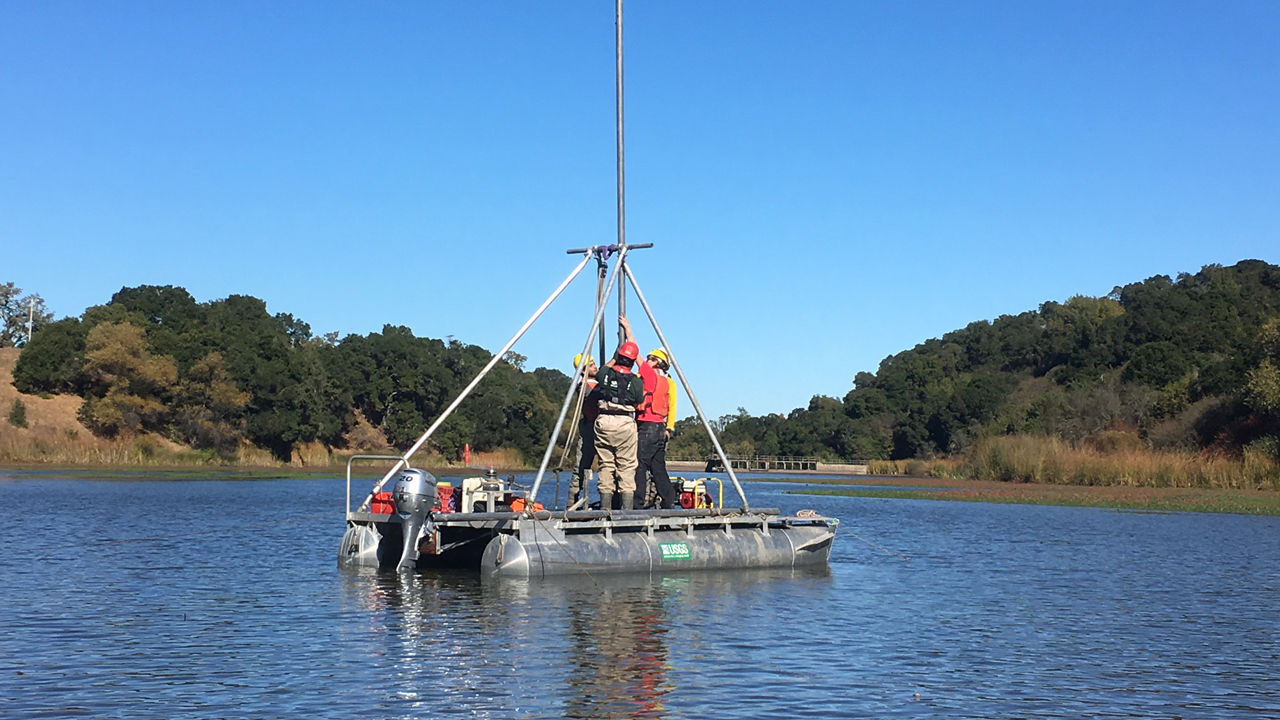|
We live in fast paced times where the human definition of long term is often next month. But the ecological and evolutionary processes driving biodiversity play out over periods ranging from decades to millennia. Part 1 of this series discussed the what of biodiversity – what it is and the challenges in defining and measuring it. In Part 2, we’ll discuss how of biodiversity – how it emerged and how it has changed over past millennia.
0 Comments
Looking out your window on a sunny day you’ll notice the different shrubs, trees, birds, and possibly a rabbit in your yard. And when you go for that hike in the park, there will be untold insects, maybe a frog, snake, or salamander. And of course, you can’t forget the wonderful morning smell of the skunk that passed through last night, or the deer quietly grazing in a neighbor’s meadow. What you just experienced in a small way is the variety of life inhabiting the Earth – the biological diversity, or biodiversity, of nature. Biodiversity underlies everything we do as Master Naturalists. At our last members meeting, Amy Johnson, the Director of Virginia Working Landscapes, discussed various biodiversity studies her group is involved with, pointing out some of the ways that scientists (and citizen scientists such as Master Naturalists) study biodiversity and its implications. Scientists, however, have long debated how to precisely define and measure biodiversity. Is it the number of species? Is it the number different functional roles being fulfilled by various species in an ecosystem? Is it the genetic diversity in a population? Is it the diversity of ecosystems and how species come together in different assemblies? The table below shows some of the many elements and dimensions that scientists consider when studying and measuring biodiversity: The figure below shows another way of looking at biodiversity. Notice the three “standard” ways that scientists typically look at biodiversity – genetic diversity, species diversity, and ecosystem diversity – and some of the alternative ways – compositional diversity, structural diversity, and functional diversity. Source: P. Duelli, M.K. Obrist / Agriculture, Ecosystems and Environment 98 (2003) 87–98 By now you’re getting the sense that biodiversity is much more than the “variety of life.” In some respects, trying to define it is akin to the parable of the blind men and an elephant.[1] In other respects, it depends on what you are studying – local habitats, food webs, a particular species, or a larger landscape or region. For example, a study of a local habitat or niche may focus on biodiversity as the number of different species in that habitat or the genetic variation of the resident populations. If the scale of the study is larger, say a watershed, landscape, or larger geographic region, the focus may be on the diversity of community assemblies or ecosystems present. Studies of food webs likely will focus on the diversity of functions different species perform. These different perspectives on biodiversity (species, functions, communities) are also not independent of each other, but interrelated. A formal definition that attempts to encompass these various dimensions of biodiversity is the 1992 Convention on Biological Diversity, an international agreement among 150 nations, which defined biodiversity as: “…the variability among living organisms from all sources including, [among other things], terrestrial, marine and other aquatic ecosystems and the ecological complexes of which they are a part; this includes diversity within species, between species, and of ecosystems.” This definition recognizes biodiversity as including genetic diversity, species diversity, and ecosystem diversity, among other dimensions and elements. How is Biodiversity Measured? It will come as no surprise that given the complexity of the biodiversity as a concept that there is not a single measure for biodiversity. Most biodiversity measures have two basic components – some measure of the number of entities present and some measure the degree of difference between those entities. For example, biodiversity can be measured by the number of species in a specific area, using such metrics as species richness (how many distinct species in an environment), or metrics such as evenness (how close in numbers each species in an environment is), rank abundance (relative species abundance), and various other species diversity indices, such as the Simpson Index or Shannon Index, that capture the degree of difference between species in a sample. Endemism richness is another type of biodiversity measurement that focuses on the proportion of rare, locally occurring endemic species. The field of biodiversity measurement is a subject that can cover several graduate courses in ecology. To illustrate the problem of measuring biodiversity, look at the illustration below - which of the two areas below do you consider to have a higher biodiversity? The two areas have the same number of individuals (20). The area on the right has more species (8) (species richness), but the ecosystem on the left has greater evenness across species as reflected in a higher Shannon Index. The Shannon Index quantifies the uncertainty in predicting the species identity of a random individual (i.e., the less difference there is among species, the greater evenness). As the Shannon index approaches zero, species differences approach zero (monoculture), hence a larger Shannon Index number is indicative of greater the biodiversity. The two areas might also be compared based on endemic richness. For example, if the ant, beetle, and frog in the right ecosystem were endemic species to that particular local area, then the ecosystem on the right might be considered more biodiverse and worthy of conservation. Biodiversity also might be measured by the variety and number of different functions that species fulfill in an ecosystem, such as primary producers, herbivores, and carnivores. Functional diversity can be measured in a number of ways (Laureto, et al., 2015; Song, et al., 2014). One way is by the complexity and connectivity of a food web and the functional roles in the food web. In Figure 2, functional diversity on the right side would likely be different from the left side (e.g., the right-side area, populated by frogs, beetles, and ants in a pine forest would likely produce different functions and food web structure than the left-side area dominated by crows and salamanders). Apart from species and functions, biodiversity might also be characterized by the degree of ecosystem diversity. Ecosystem diversity is the largest scale of biodiversity measurement, and within each ecosystem, there is a great deal of both species and genetic diversity. In Figure 2, one could study biodiversity by comparing the differences in communities and species assemblies between the left and right side “ecosystems”. An example of ecosystem diversity is the Southern Appalachian region—stretching from West Virginia and southwestern Virginia to northern Alabama. This region has a number of diverse ecosystems which contributes to the area’s high biodiversity. ------------- Fun Fact: Virginia has over 3800 species, including the third-highest number of amphibian species, and the 13th highest number of vascular plant species in the United States. ------------ Within this region, Virginia has a variety of physiographic areas—from western mountains and valleys, to rolling hills, to Tidewater estuaries— that provide many habitats supporting a wide variety of ecosystems. For example, the Clinch Mountain Wildlife Management Area—covering about 25,000 acres in Russell, Smyth, Tazewell, and Washington counties—is considered to be Virginia’s “most biologically diverse [management area], due in large part to the vast differences in elevation on the area” and is particularly known for the diversity of fish and mussels in the area’s watersheds. On the other side of the state, the aquatic ecosystems and wetlands of the Chesapeake Bay and Virginia’s southern coastal environments are sites of significant biodiversity. Master Naturalists and Biodiversity As a Master Naturalist, you are involved with biodiversity at every turn. Stream monitoring and water quality assessments are based on sampling the macro-invertebrate species richness found in a particular reach of a stream. Butterfly surveys record the number and differences in species found in a local area. Volunteer work on native plants, pollinator gardens, and habitat restoration is fundamentally aimed at supporting greater biodiversity. Feeder Watch and the Great Backyard Bird Count help assess the diversity of local bird populations. And that ubiquitous invasive plant removal projects, and more recently our work with Spotted Lanternfly monitoring, are aimed at threats to biodiversity. I am hard pressed to think of any project we undertake as Master Naturalists that is not tied either directly or indirectly to biodiversity. There are a number of resources you can use for further insights about biodiversity – some our listed below in further reading and references. Also, on the ORMN website there are blogs, science research, news articles and other resources on various aspects of biodiversity. In the next installment of this series, we’ll travel back in time a few hundred million years to see how biodiversity has waxed and waned over the millennia. Until then, get out and enjoy the variety of life around you! Further Reading The Diversity of Life, by Edward O. Wilson (1992, Harvard University Press) The Invention of Nature: Alexander Von Humboldt’s New World, by Andrea Wulf (2016, Knopf) Evolution: The Triumph of an Idea, by Carl Zimmer (2006, Harper Collins) References Duelli, P. and M. Obrist, (2003). Biodiversity indicators: the choice of values and measures, Agriculture, Ecosystems and Environment, 98: 87-98. Gaston, K.J. and Spicer, J.I. (2004). Biodiversity: An Introduction, Blackwell Publishing, 2nd Edition Laureto et al., (2015). Functional diversity: an overview of its history and applicability, Natureza & Conservação, 13(2): 112-116, doi.org/10.1016/j.ncon.2015.11.001. Ecosystems and Human Well-Being: Biodiversity Synthesis, by The Millennium Ecosystem Assessment (2005, World Resources Institute) Mora, C.; et al. (2011). "How Many Species Are There on Earth and in the Ocean?". PLOS Biology. 9 (8): e1001127. doi:10.1371/journal.pbio.1001127. Song et al, (2014). Relationships between functional diversity and ecosystem functioning: A review. Acta Ecologica Sinica. 34: 85–91. Doi: 10.1016/j.chnaes.2014.01.001. Tilman, David (2012). Biodiversity and Environmental Sustainability amid Human Domination of Global Ecosystems, Daedalus, 141(3): 108-120, Summer 2012. --------------------------- [1] The parable is a story of a group of blind men who have never come across an elephant before and who learn and conceptualize what the elephant is like by touching it. Each blind man feels a different part of the elephant's body, but only one part, such as the side or the tusk. They then describe the elephant based on their limited experience and their descriptions of the elephant are different from each other. ---------------------------------- BONUS FEATURE
SERC: Landscaping for Biodiversity: A plant-insect perspective Webinar Recording Also, please find additional resources provided by Dr. Burghardt:
Email: kburghar@umd.edu Website: www.burghardtlab.org Twitter: @plantinsectppl 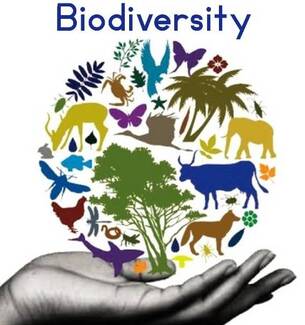 The variety of life on the Earth is an enduring source of wonderment and mystery. Whether you are bird watching in your backyard, counting invertebrates to assess stream quality, planting oak trees and native plants in your local park, or hiking through Shenandoah National Park, the diversity of life is all around you. Its why you look out your window in the morning and stock the bird feeder in the winter. Biodiversity is at the core of everything we do as Master Naturalists. Whether it’s citizen science projects, stewardship, or education outreach, a Master Naturalist must understand the patterns of nature -- the interconnected relationships between plants, birds, trees, insects, mammals and their environment. Without biodiversity, there would be no patterns or relationships in nature to observe. There would be no nature. So how did biodiversity arise, what is biodiversity, and how is it changing over time? In this six-part series, I will explore each month the many facets of biodiversity, what it means for us, and how we can sustain it. The series will cover the following topics:
So put on your wonderment goggles (free with three box tops and a self-addressed stamped envelope) and come along for the ride…..
By drilling into lake bottoms, researchers collect mud cores with fossil pollen that reveal the history of plants.
ANTHONY BARNOSKY By Elizabeth Pennisi Science Aug. 5, 2020 , 12:00 PM Recent human activity, including agriculture, has had a greater impact on North America’s plants and animals than even the glaciers that retreated more than 10,000 years ago. Those findings, presented this week at the virtual annual meeting of the Ecological Society of America, reveal that more North American forests and grasslands have abruptly disappeared in the past 250 years than in the previous 14,000 years, likely as a result of human activity. The authors say the new work, based on hundreds of fossilized pollen samples, supports the establishment of a new epoch in geological history known as the Anthropocene, with a start date in the past 250 years. “It’s hard to overemphasize how profound the effects of ending a glacial cycle are,” says Zak Ratajczak, an ecologist at Kansas State University, Manhattan, who was not involved with the work. “So for humans to have that kind of impact is pretty amazing.” For more than 10 years, researchers have debated when humans started to make their mark on the planet. Some argue agriculture transformed landscapes thousands of years ago, disrupting previously stable interactions between plants and animals. Others argue the launch of large-scale mining and smelting operations—seen in glacial records going back thousands of years—means the Anthropocene predates the industrial revolution. For geologists, however, the epoch starts with a different signal: nuclear explosions and a sharp uptick in fossil fuel use in the mid–20th century. But some skeptics suggest the ice ages have had an even greater effect on the world’s ecosystems. To test that idea, Stanford University paleoecologist M. Allison Stegner turned to Neotoma, a decade-old fossil database that combines records from thousands of sites around the world. Her question: When—and how abruptly—did ecosystems change in North America over the past 14,000 years? Climate-altering glaciers, which started their retreat roughly 20,000 years ago, pulsed back during a cold period called the Younger Dryas, from about 12,800 until 11,700 years ago. After that, North America abruptly warmed, marking the beginning of our current epoch, the Holocene. To answer her question, Stegner and colleagues looked at how vegetation shifted in locations across North America, using fossilized pollen to determine which species of plants were present at any given time. From 1900 records of mud cores drilled from lake bottom, Stegner found 400 with enough fossil pollen—and accurate enough dating—to analyze. She and her colleagues then tracked how the mix of pollen in each core changed over time, paying close attention to abrupt shifts. Such shifts can mark the transformation of an entire ecosystem, for example, when a grassland becomes a forest or when a spruce forest changes into an oak forest. Looking at 250-year intervals, the researchers ran two types of statistical analyses that separately picked out temporary and long-term disruptions. “Allison used some very creative and rigorous methods,” says Jennifer McGuire, a paleoecologist at the Georgia Institute of Technology who was not involved with the work. When the last ice age ended, forests and grasslands regrew across North America, creating a landscape that remained stable for thousands of years. But humans have changed all that, Stegner reports this week. Her team found just 10 abrupt changes per 250 years for every 100 sites from 11,000 years ago to about 1700 C.E. But that number doubled, to 20 abrupt changes per 100 sites, in the 250-year interval between 1700 and 1950. When the ice sheets of the Younger Dryas retreated, starting about 12,000 years ago, that number was 15. This suggests, Stegner says, that human activity starting 250 years ago—from land use change to pollution and perhaps even climate change—had more of an impact on ecosystems than the last glaciers. The researchers also analyzed whether some regions have changed more swiftly than others. Over the past 250 years the U.S. Midwest, Southwest, and Southeast have undergone massive shifts from forest, grassland, and desert ecosystems to agriculture and tree plantations, she says. In contrast, Alaska, northern Canada, and parts of the Pacific Northwest underwent more changes as the glaciers melted than in the past 250 years. “We already know plenty about climate change,” says Kai Zhu, an ecologist at the University of California, Santa Cruz. “This study adds land use change, [which] might accelerate climate change in altering plants at a continental scale.” That’s worrisome, McGuire adds, because plants are the foundation of an ecosystem. “This rapid turnover is a harbinger of the extinction risk and the overall ecosystem disruption that is impending,” she says. At another meeting session, she and student Yue Wang reported “very similar trends” after using pollen to examine how forests, tundra, deserts, and other biomes have bounced back from disruptions through time. Combined, the new work “eliminates any doubt” that humans have set off a new geologic epoch, Stegner says. doi:10.1126/science.abe1902  By Lauren Harper, guest blogger for State of the Planet, Earth Institute, Columbia University Every autumn, as winter winds begin to blow and rain colorful leaves from the trees, you may notice the dierences in each leaf’s color and shape. This is a form of biodiversity, or the variety of living organisms on earth. Biodiversity can be seen within species, between species, and within and between ecosystems. Although biodiversity is hard to measure on a global scale, in recent years there has been scientic consensus that the planet’s biodiversity is in decline. That’s not great news, because in general, the more species that live in an area, the healthier that ecosystem is—and the better off we humans are. Why Biodiversity Matters Healthy ecosystems require a vast assortment of plant and animal life, from soil microbes to top level predators like bears and wolves. If one or more species is removed from this environment, no longer serving its niche, it can harm the ecosystem. Introducing foreign or invasive species into a habitat can have similar results, as the invasive species can out-compete the native species for food or territory. Biodiversity affects our food, medicine, and environmental well-being. Dragonflies, ladybugs and beetles pollinate many of the crops we rely on for food, as well as plants in natural ecosystems. One type of pollinator cannot do it all, hence the importance of biodiversity. Loss of habitat—for example, when humans convert meadows into parking lots or backyards—is reducing pollinator populations. If pollinators were to disappear entirely, we would lose over one-third of all crop production. This would reduce or eliminate the availability of foods like honey, chocolate, berries, nuts and coffee. Many modern medicines, like aspirin, caffeine and morphine, are modeled after chemical compositions found in plants. If undiscovered or uninvestigated wildlife species disappear, it would disadvantage scientists trying to uncover new sources of inspiration for future vaccines and medications. Biodiversity also provides ecosystem services or benefits to people. These benefits include: hurricane storm surge protection, carbon sequestration, water filtration, fossil fuel generation, oxygen production and recreational opportunities. Without a myriad of unique ecosystems and their respective diverse plant and animal life, our quality of life may become threatened. Climate Impacts To many, the term “climate change” feels like a buzzword that encompasses a large amount of negative impacts. Climate means the average weather conditions in an area over a long period of time—usually 30 years or longer. A region’s climate includes systems in the air, water, land and living organisms. Climate change is the shift or abnormal change in climate patterns. As the planet warms quickly, mostly due to human activity, climate patterns in regions around the world will fluctuate. Ecosystems and biodiversity will be forced to fluctuate along with the regional climate, and that could harm many species. These climate change impacts are in part due to how we have altered land use. Turning natural areas into cities or agricultural fields not only diminishes biodiversity, but can make warming worse by chopping down trees and plants that help cool the planet. Changes in climate can also intensify droughts, decrease water supply, threaten food security, erode and inundate coastlines, and weaken natural resilience infrastructure that humans depend on. Politicians have proposed several solutions, plans and international agreements to tackle the long-standing issues that biodiversity loss and climate change present. In the meantime, we as individuals can take small actions in our daily lives to reduce our environmental impacts on the planet. Unplugging your unused appliances, changing to LED lightbulbs, carpooling, and participating in meatless Monday are all ways we can help to slow climate change. Growing native plants and staying informed about the origins and the ethics behind the products you purchase is another way you can help. These types of behavioral shifts can steer businesses and policy makers toward incorporating sustainable practices that reduce greenhouse gas emissions and halt biodiversity loss. Lauren Harper is an intern in the Earth Institute communications department. She is a graduate student in the Environmental Science and Policy Program at Columbia’s School of International and Public Affairs. Also read: Climate Change Is Becoming a Top Threat to Biodiversity - click here Habitat loss doesn’t just affect species, it impacts networks of ecological relationships - click here |
Have a blog or blog idea?
Let us know (click) Other Blogs
VA Native Plant Society - click Brenda Clement Jones - click John Muir Laws' Blog - click Megan's Nature Nook - click Categories
All
Archives
September 2023
Blog Administrator:
Kathleen A. VMN since 2018 |
